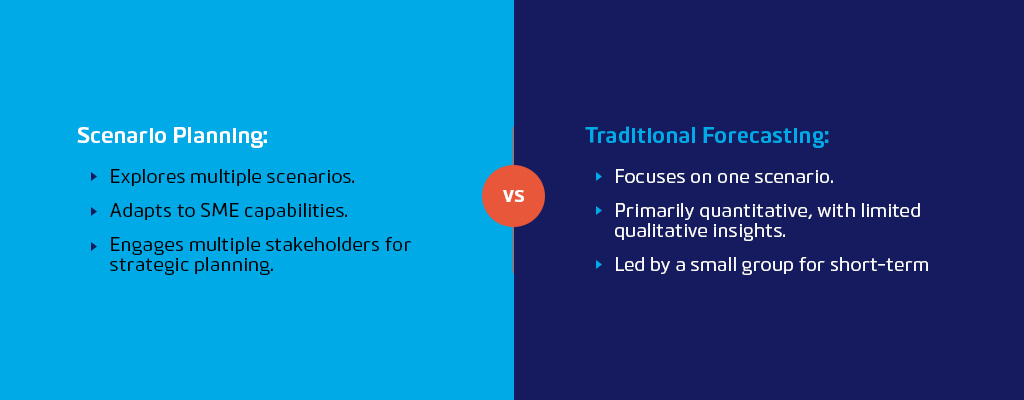In today’s fast-paced and unpredictable business landscape, traditional forecasting methods often fall short when it comes to preparing for an uncertain future, especially for small and medium-sized enterprises (SMEs). This is where scenario planning steps in as a strategic tool tailored to help businesses not only anticipate potential outcomes but also adapt and thrive in the face of uncertainty. In this comprehensive guide crafted for SMEs, we will explore the essence of scenario planning, its key components, how it differs from traditional forecasting, why it’s crucial for small businesses, and how to effectively implement it to ensure your business is ready for whatever the future holds.
Understanding Scenario Planning
In today’s uncertain world, SME decision-making is like building on shifting ground. Traditional planning relies on a single, fixed future, but reality doesn’t follow this linear path. Scenario planning is a strategic method for businesses to prepare for a dynamic future. It involves crafting multiple plausible scenarios, from optimistic to pessimistic, enabling informed decisions in an uncertain environment.

Key Components of Scenario Planning
Scenario planning consists of several key components, each playing a crucial role in the process:
- Identifying Key Factors and Data: Start by asking crucial questions specific to your business, like market threats, geopolitical factors, and internal influences. Pinpoint the needed data sources tailored to your business size and needs.
- Identifying and Factoring in External Forces: SMEs exist within an external ecosystem, albeit on a smaller scale. This encompasses factors like changing customer preferences and local economic conditions. Scenario planning for SMEs involves assessing these influences in your businesses unique context.
- Prioritising Uncertainties: With limited resources and a smaller operational scale, SMEs must prioritise the most critical uncertainties that could significantly affect their business. This step helps SMEs focus their efforts on addressing the most impactful scenarios within their scope.
- Telling the Story of the Scenario: Rather than diving straight into numbers, scenario planning begins with developing a compelling narrative for each scenario. Crafting a story makes the scenario more tangible and relatable, even for smaller teams.
- Running the Data Through the New Model: After defining the scenarios and their stories, businesses need to quantify the data to create models that reflect each scenario. Continuous refinement and questioning of assumptions ensure the models are robust and consider your businesses unique capabilities.
Scenario Planning vs. Traditional Forecasting
A fundamental distinction between scenario planning and traditional forecasting lies in their approach, especially when tailored for SMEs:

Why SMEs Need Scenario Planning
Scenario planning breaks from traditional forecasting, benefiting SMEs by mitigating risks, seizing opportunities, and fostering strategic growth. It equips businesses to proactively prepare for disruptions with tailored scenarios, capitalises on their strengths, and aligns strategies with dynamic business environments.
How to Use Scenario Planning Effectively for SMEs
Effectively applying scenario planning for your business demands a strategic process. Start by identifying the major drivers shaping your SME’s future, delving into societal shifts, technological advancements, economic trends, and relevant local political changes within your specific context.
Next, focus on the most impactful uncertainties arising from these drivers, carefully selecting variables aligning with your businesses capabilities. Then, create diverse, plausible scenarios by combining these critical uncertainties, considering their intricate interplay. Envision various future outcomes within your businesses realm of possibilities.
Finally, conclude with a comprehensive discussion, exploring the implications of each scenario. These conversations will guide your business in tailoring its strategies to effectively respond to potential futures, aligning with its unique strengths and limitations.
Pitfalls to Avoid for SMEs
While scenario planning is effective, SMEs must avoid common pitfalls. Firstly, avoid overcomplicating scenarios, especially with limited resources. Focus on critical uncertainties that align with your businesses context and objectives. Additionally, don’t believe that scenario planning means selecting a single scenario to base your strategy on. Instead, prepare for multiple potential futures to ensure resilience tailored to your businesses size.
Another pitfall is neglecting the long term. Don’t fixate solely on short-term considerations. Scenario planning encourages SMEs to anticipate market and local competitor changes over several years, vital for strategic preparedness in dynamic business landscapes.

Real-Life Examples for SMEs
Scenario planning demonstrates significant value across various Australian industries, particularly those impacting SMEs. In the agricultural sector, numerous small-scale Australian farmers employ scenario planning to anticipate harvest outcomes, crucial given the country’s susceptibility to unpredictable weather conditions. This foresight aids accurate sales projections and informs vital investment decisions, aligning seamlessly with their unique operational context in Australia’s agricultural landscape.
Reflecting on Australian business history, parallels emerge in the missed opportunities of industry giants like Blockbuster and Kodak. They failed to embrace disruptive changes, highlighting the importance of scenario planning, even for smaller Australian businesses. SMEs can learn from these cautionary tales, emphasising the need to consider diverse potential futures and their consequences. This practice proves invaluable in helping businesses maintain a competitive edge in the ever-evolving Australian marketplace, albeit on a smaller scale.
Tools and Support for SMEs
Implementing tailored scenario planning for your business might appear daunting, but resources are available to assist you. Tools designed specifically for SMEs can simplify scenario modelling, making it manageable and cost-effective. Additionally, consulting with scenario planning experts, like Beyond Advisors, who understand the unique challenges faced by SMEs can streamline the process and offer valuable support during planning sessions.
In today’s rapidly changing world, businesses can’t rely solely on historical data and linear forecasting to navigate the future. Scenario planning provides a dynamic and forward-thinking approach to strategic decision-making, tailored to small and medium-sized enterprises’ capabilities and context. By crafting multiple plausible scenarios, SMEs can adapt, mitigate risks, seize opportunities, and thrive in uncertain times. Embrace scenario planning as a powerful, customised tool to guide your business through the complexities of an ever-evolving business landscape.
If you would like to learn more about how scenario planning can benefit your business contact our friendly team today on 1300 784 213 or visit our website www.beyondadvisors.com.au.